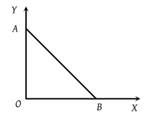When one electron is taken towards the other electron, then the electric potential energy of the system -
1. Decreases
2. Increases
3. Remains unchanged
4. Becomes zero
Four charges are placed at the corners of a square taken in order. At the centre of the square
1.
2.
3.
4.
Point charge q1 = 2 μC and q2 = –1 μC are kept at points x = 0 and x = 6 respectively. Electrical potential will be zero at points
1. x = 2 and x = 9
2. x = 1 and x = 5
3. x = 4 and x = 12
4. x = –2 and x = 2
Equipotential surfaces associated with an electric field which is increasing in magnitude along the x-direction are
1. Planes parallel to yz-plane
2. Planes parallel to xy-plane
3. Planes parallel to xz-plane
4. Coaxial cylinders of increasing radii around the x-axis
A bullet of mass 2 gm is having a charge of 2 μC. Through what potential difference must it be accelerated, starting from rest, to acquire a speed of 10 m/s ?
1. 5 kV
2. 50 kV
3. 5 V
4. 50 V
In a certain charge distribution, all points having zero potential can be joined by a circle \(S.\) The points inside \(S\) have positive potential, and points outside \(S\) have a negative potential. A positive charge, which is free to move, is placed inside \(S.\) What is the correct statement about \(S\):
| 1. | It will remain in equilibrium |
| 2. | It can move inside \(S,\) but it cannot cross \(S\) |
| 3. | It must cross \(S\) at some time |
| 4. | It may move, but will ultimately return to its starting point |
A square of side ‘a’ has charge Q at its centre and charge ‘q’ at one of the corners. The work required to be done in moving the charge ‘q’ from the corner to the diagonally opposite corner is -
1. Zero
2.
3.
4.
As per this diagram a point charge +q is placed at the origin O. Work done in taking another point charge –Q from the point A [co-ordinates (0, a)] to another point B [co-ordinates (a, 0)] along the straight path AB is

1. Zero
2.
3.
4.
Two charges \(q_1\) and \(q_2\) are placed \(30~\text{cm}\) apart, as shown in the figure. A third charge \(q_3\) is moved along the arc of a circle of radius \(40~\text{cm}\) from \(C\) to \(D.\) The change in the potential energy of the system is \(\dfrac{q_{3}}{4 \pi \varepsilon_{0}} k,\) where \(k\) is:

| 1. | \(8q_2\) | 2. | \(8q_1\) |
| 3 | \(6q_2\) | 4. | \(6q_1\) |
Two thin wire rings each having a radius R are placed at a distance d apart with their axes coinciding. The charges on the two rings are +q and –q. The potential difference between the centres of the two rings is -
1. Zero
2.
3.
4.






